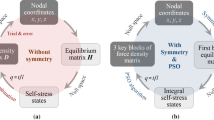Conclusions
The total potential energy surfaces (ΔV-surfaces) in the adjacent neighborhood of the initial position of the two perfect pin-jointed frames studied in examples 1 and 2 are confined to a three-dimensional space since only two of the members were assumed to be on the point of buckling. If however more than two members of a frame can contract flexurally, the representation of the ΔV-surfaces is not so simple. The negative regions of the ΔV-surface are of primary interest in the study of the post-buckling hehaviour of a frame since then an accelerated motion of the system away from the initial position of the frame may ensue. Therefore in the case of a multi-dimensional surface the location of the negative regions of the surface and the evaluation of the corresponding unstable modes of the given frame may be carried out more conveniently analytically using the expressions given by (2.8) and (2.9).
In order to prove that the system is in unstable equilibrium, when the frame is on the point of buckling, it suffices to find at least one adjacent position for which ΔV is negative. This may be a much easier task in the case of a complex frame than representing the entire “shape” of the surface in a multi-dimensional adjacent space so that the choice of a particular post-buckling mode or the possibility of a “snap-through” from one mode into another may be fully understood. Similarly, in the case of stable equilibrium of the system when a given frame is on the point of buckling, the result may be obtained quickly if the test for positive definiteness of the quadratic from in the expression for ΔV is carried out.
The effect of initial imperfections in the members becomes apparent on comparing the loaddisplacement characteristic of the frame in example 1 with the slope to the equilibrium path for the perfect frame. It is observed that adequate agreement between the two is established when the buckling mode is more fully developed.
Then clearly, the initial imperfections in the members can be expected to affect the initial regions of the total potential energy surfaces, but agreement between such surfaces for perfect as well as in perfect frames may be adequate after the initial distortions of the imperfect frame have been overcome.
Consequently the ΔV surfaces as well as the stability criterion formulated for perfect frames by expressions 2.10 and 2.11 will in general give an indication of the post-buckling behavior of pin-jointed elastic frames when their members possess initial imperfections.
Similar content being viewed by others
Author information
Authors and Affiliations
Additional information
This paper represents a part of the Investigation into the Post Buckling Behavior of Frames sponsored by the Aluminium Development Association of Great Britain and carried out by the author at Cambridge University from the years 1957 to 1960.
Rights and permissions
About this article
Cite this article
Britvec, S.J. Overall stability of pin-jointed frameworks after the onset of elastic buckling. Ing. arch 32, 443–452 (1963). https://doi.org/10.1007/BF00531792
Received:
Issue Date:
DOI: https://doi.org/10.1007/BF00531792




